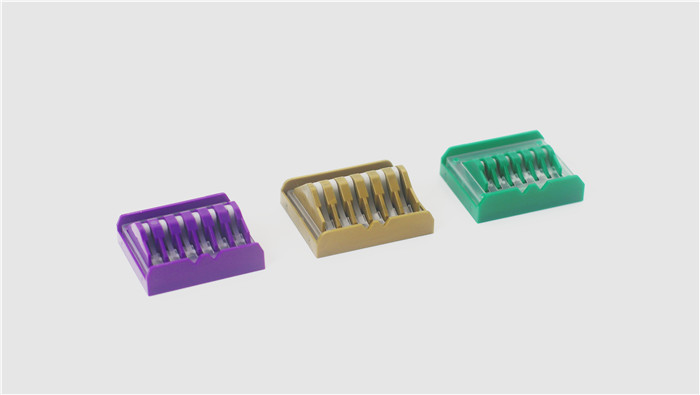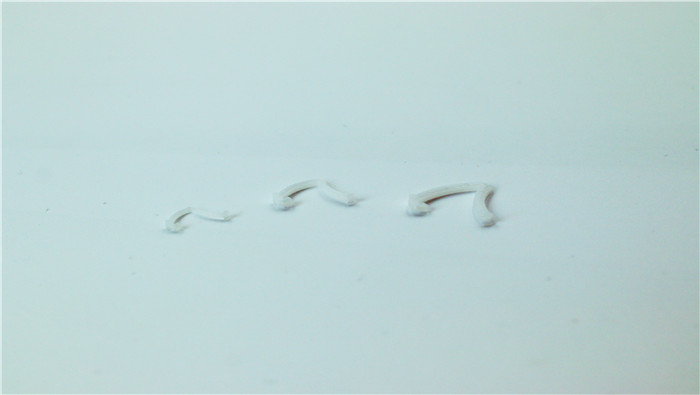

POM (polyoxymethylene) is widely used in the manufacture of medical devices such as disposable tissue ligating closure clips due to its high rigidity, wear resistance and biocompatibility. The injection molding process requires fine control of the parameters of crystallization, melting, injection and other stages to ensure the mechanical strength and functional stability of the device. The following combination of material properties and process requirements, analyze the core control points in stages:
I.Drying and pretreatment stage: to eliminate moisture interference
POM hygroscopicity is low (0.2% -0.5%), but a small amount of moisture may still lead to injection molding bubbles, silver wire and other defects. Need to pay attention to:
Drying conditions: wet raw materials need to be dried at 80-90 ℃ for 2-4 hours, so that the moisture content ≤ 0.1%.

II.the melting stage: temperature and residence time control
POM thermal stability is poor, high temperature or long stay easy to decompose (release of formaldehyde gas), need to be strictly controlled:
barrel temperature: copolymerization of POM recommended 190-210 ℃, homopolymerization of POM 190-230 ℃, to avoid exceeding 240 ℃.
Dwell time: copolymer POM at 205 ℃ to stay ≤ 20 minutes, homopolymer POM at 215 ℃ ≤ 35 minutes.
Screw Cleaning: The barrel needs to be cleaned with PP/PE when stopping to prevent the residue from triggering degradation.
III.injection stage: pressure and speed optimization

POM melt fluidity is sensitive to the shear rate, the injection parameters need to be adjusted through the mold filling effect:
Injection pressure: range 80-140MPa, high pressure can enhance the fluidity, reduce shrinkage.
Injection speed: medium to fast (to avoid ripples caused by slow speed, fast trigger shear overheating).
Back pressure control: ≤ 10MPa, to prevent melt overheating and nozzle salivation.
IV.cooling and crystallization stage: mold temperature and structural design
POM is a highly crystalline material, the cooling rate directly affects the degree of crystallinity and shrinkage:
Mold temperature: 80-120 ℃, higher temperature (≥ 90 ℃) can reduce the shrinkage (1.8% -3.5%), enhance the surface finish.
Gate design: round gate diameter ≥ 0.5 times of wall thickness, rectangular gate width ≥ 2 times of wall thickness, depth 0.6 times to reduce stress concentration.
Exhaust system: thickness of exhaust groove 0.01-0.04mm to avoid trapped gas leading to scorching.

V. Post-treatment and Quality Verification Stage: Eliminate residual stress
Annealing Treatment: Heat treatment (e.g. 100℃ oven treatment for 2 hours) for precision closure clamps to eliminate internal stress and prevent cracking.
Performance test:
Mechanical verification: tensile strength ≥50MPa, elongation at break ≥200% (ASTM D638).
Sealability test: the closure of the clip lock buckle to withstand ≥ 50N axial tension without slipping.
Sixth, anti-degradation and pollution control
Metal pollution avoidance: avoid copper parts contact with the melt (copper accelerated POM degradation).
Impurity control: the barrel needs to be thoroughly cleaned before injection, to prevent halogen polymer residue triggered decomposition.
Conclusion
POM injection molding process needs to run through the “temperature accuracy, pressure gradient, structural adaptation” principle, through the drying pretreatment, melt temperature control, injection parameter optimization, mold temperature control design and post-processing process, systematic protection of the mechanical strength and functional reliability of the closure clamp. In the future, we can explore the application of intelligent process monitoring (e.g. melt temperature sensor) and modified POM (glass fiber reinforced) to further improve product performance and mass production stability.
+86 18361958211
marketing@cndonho.com
+86 18361958211
No.2 Zhiwei Road, Qiandeng Town, Kunshan City, Jiangsu Province, China




